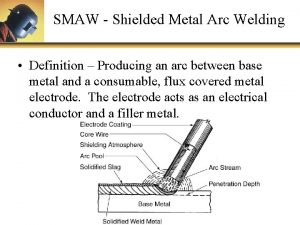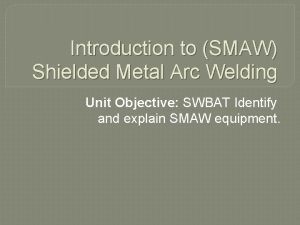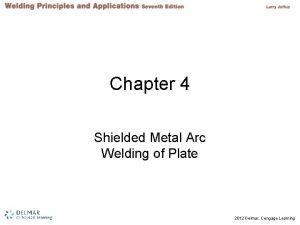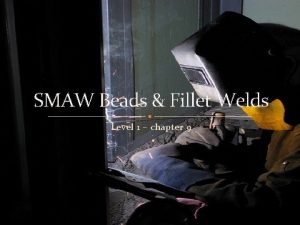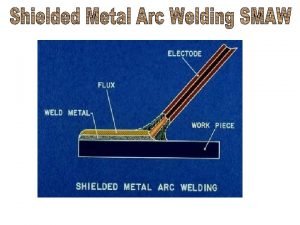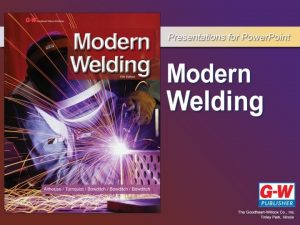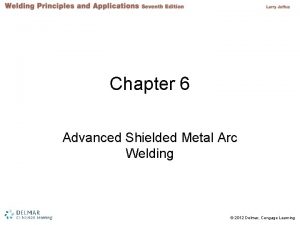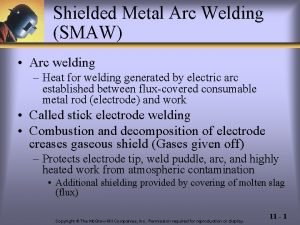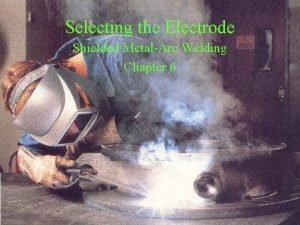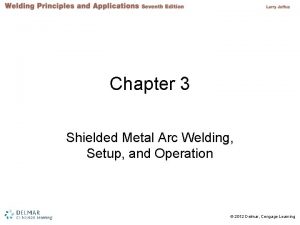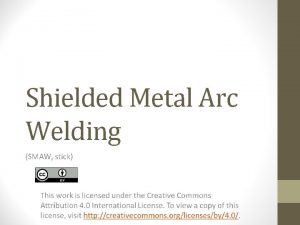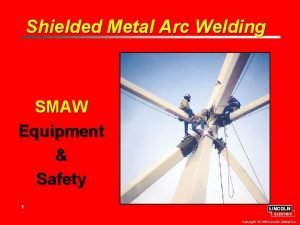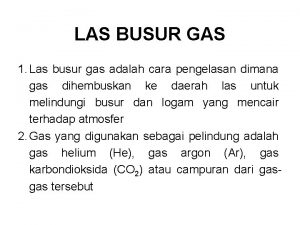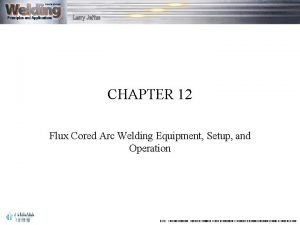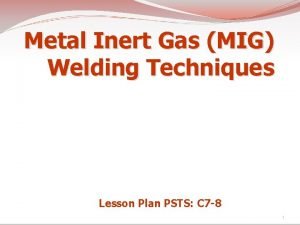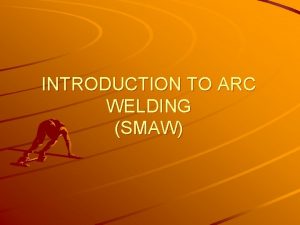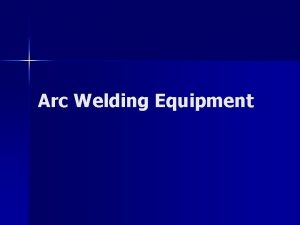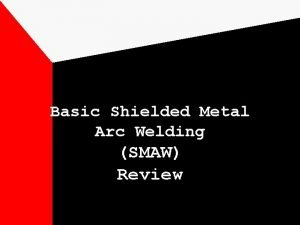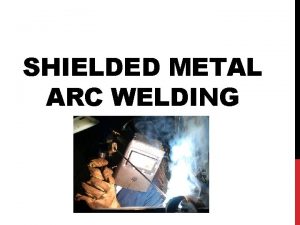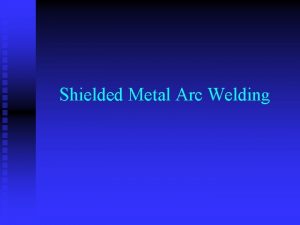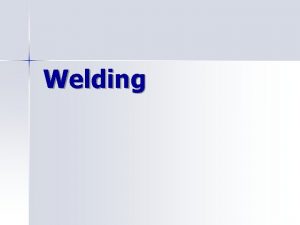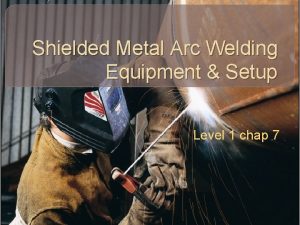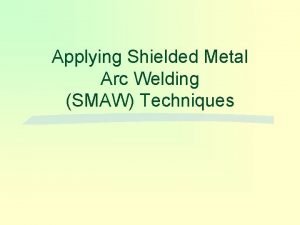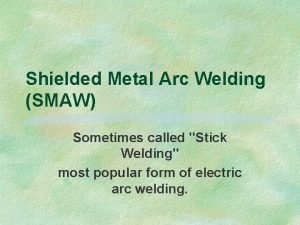Shielded Metal Arc Welding An Introduction Shielded Metal




















- Slides: 20

Shielded Metal Arc Welding: An Introduction

Shielded Metal Arc Welding Defined: n n The Shielded Metal Arc Welding process is a consumable welding process where an arc is generated between the grounded work-piece and the electrode. Heat from the arc melts the electrode and the metal being welded allowing them to be joined into a solid piece. The molten weld puddle is protected from the atmosphere by a “gaseous envelope” that is created when the electrode coating is vaporized by the heat of the arc. It is the oldest of all the arc welding processes.

SMAW Equipment Requirements: n n n Constant current power source (AC, DC or AC/DC). Welding cables with electrode holder and ground clamp. Electrodes

Advantages of the SMAW Process: n n n Cheapest common arc welding equipment to purchase. Used to weld ferrous and non-ferrous metal. All position welding. Ideally suited for outdoor work. Highly portable. Consumables and equipment readily available.

Disadvantages of the SMAW Process n n n Low productivity, especially when compared to the GMAW process. High amount of electrode loss. Dirtiest of the common arc welding processes. Requires much post weld clean-up. Can be difficult to master.

SMAW Variables: In order to create consistent, quality welds using the SMAW process, the operator must know and control the following welding variables: n Welder polarity setting. (based on electrode type and material thickness). n Initial amperage setting (based on electrode size and type). n Electrode angle: 10 to 20 degrees in the trailing or drag direction. n Arc length: One electrode diameter n Travel speed: Finished beads should be three electrode diameter in width. n Electrode manipulation (if needed)

Troubleshooting Quality Issues in SMAW Welds: n n Excessive weld bead width; reduce amperage setting and/or increase travel speed. Excessive weld bead convexity; increase amperage setting. Lack of weld puddle control; reduce amperage setting and/or reduce arc length. Lack of bead width: increase amperage setting and/or reduce travel speed.

Welding Power Sources n n n A welding machine must be able to meet changing load and environmental conditions constantly. It must deliver the exact amount of electrical current at precisely the right time to the welding arc in order to control arc behavior and make welds of consistent quality. The arc welding process requires enough electric current (measured in amperes) to produce melting of the work and the electrode and the proper voltage (measured in volts) to maintain the arc.

n n Welding power sources are also known as power supplies or welding machines. All machines are classified by: OUTPUT SLOPE, whether constant current or constant voltage. POWER SOURCE TYPE, such as a transformer, transformer rectifier, inverter or generator.

OUTPUT SLOPE n n n The relationship between the output voltage and output current of the machine as the current or welding workload is increased or decreased. Output slope determines how much the welding current changes for a given change in the work voltage. Therefore, it permits the welding machine to control the welding heat and maintain a stable arc.

n n n SMAW and GTAW require a steep output slope from a constant current welding machine. (Constant current is required to control the stability of the arc) GMAW and FCAW require a relatively flat output slope from a constant voltage power to produce a stable arc. Submerged arc welding is adaptive to either slope, depending on the application and extra control equipment.

n n n n n Arc Voltage Open Circuit Voltage voltage generated by the machine at an idle when no welding is being done Arc Voltage voltage generated between the work and electrode during welding determined by the arc lengthened arc increases arc voltage and decreases current shortened arc decreases arc voltage and increases current Load Voltage voltage at the output terminals of the welding machine while when an arc in going

Types of Power Sources (Constant Current Welding Machines ) n n n Engine-Driven Generators powered by gas or diesel combustion engine also can be powered by AC or DC electric motor rarely found in industry today produce AC, DC, or AC/DC welding current

n n n Transformer-Rectifiers use a basic electrical transformer to step down AC line power voltage to AC welding voltage passes through a rectifier to convert AC output to DC welding current transformer rectifiers may be either DC or AC/DC welding current most versatile or flexible as far as type of output (DCEN or DCEP) can be used for stick welding, GTAW, submerged arc welding, multiple-operator systems, and stud welding

n n AC Transformers use an electrical transformer to step down the AC line power voltage to AC welding voltage.

n n n Inverters increases frequency of incoming primer power smaller sized machine improved electrical characteristics for welding such as faster response time and more control for pulse welding may be constant current, constant voltage or both can produce AC or DC welding current

Constant Current Welding Machines n n n Relatively small change in current (amperage) no voltage adjustment open circuit voltage can be adjusted with fine current adjustment dial on machines have dual control

Duty Cycles n n n Current output range from 100 amperes to more than 1500 amperes machines are not required to provide current continuously machine idles when operator changes electrodes, changes position, adjust settings, sets up work, and cleans the welds between passes machines rated at 200 amperes or more, the output rating is based on 60 percent duty cycle. this means the machine can deliver its rated load output for 6 out of 10 minutes

Power Supply Ratings n Power sources are rated by: Current Output n current output in amperes n Open Circuit Voltage n voltage the machine can produce at idle n Duty Cycle n percentage of any given 10 minute period that a machine can operate at its rated current without overheating n Efficiency n relationship of secondary power output to primary power input percentage determined by losses through the machine when actually welding at rated current and voltage n n

Correct Filter Plates for SMAW n n n SHADE NUMBER 6 8 10 12 14 WELDING CURRENT up to 30 amps 30 -75 amps 75 -200 amps 200 -400 amps above 400 amps
 Shielded metal arc welding (smaw) definition
Shielded metal arc welding (smaw) definition Smaw tools
Smaw tools Welding bead patterns
Welding bead patterns Chapter 3 shielded metal arc welding
Chapter 3 shielded metal arc welding Stick welding weave bead
Stick welding weave bead Mma welding
Mma welding Dcen in welding
Dcen in welding Chapter 6 shielded metal arc welding
Chapter 6 shielded metal arc welding Smaw and gmaw use constant current arc welding machines
Smaw and gmaw use constant current arc welding machines Fill freeze electrode
Fill freeze electrode Chapter 3 shielded metal arc welding
Chapter 3 shielded metal arc welding Shielded metal arc welding definition
Shielded metal arc welding definition Stinger welding definition
Stinger welding definition Las busur gas
Las busur gas Rutile based flux definition
Rutile based flux definition Rmd welding
Rmd welding Smaw definition
Smaw definition Arc promoteur vs arc investigateur
Arc promoteur vs arc investigateur Minor arc and major arc
Minor arc and major arc What is an minor arc
What is an minor arc Arc emu88 com arc info 45 100045 html
Arc emu88 com arc info 45 100045 html
